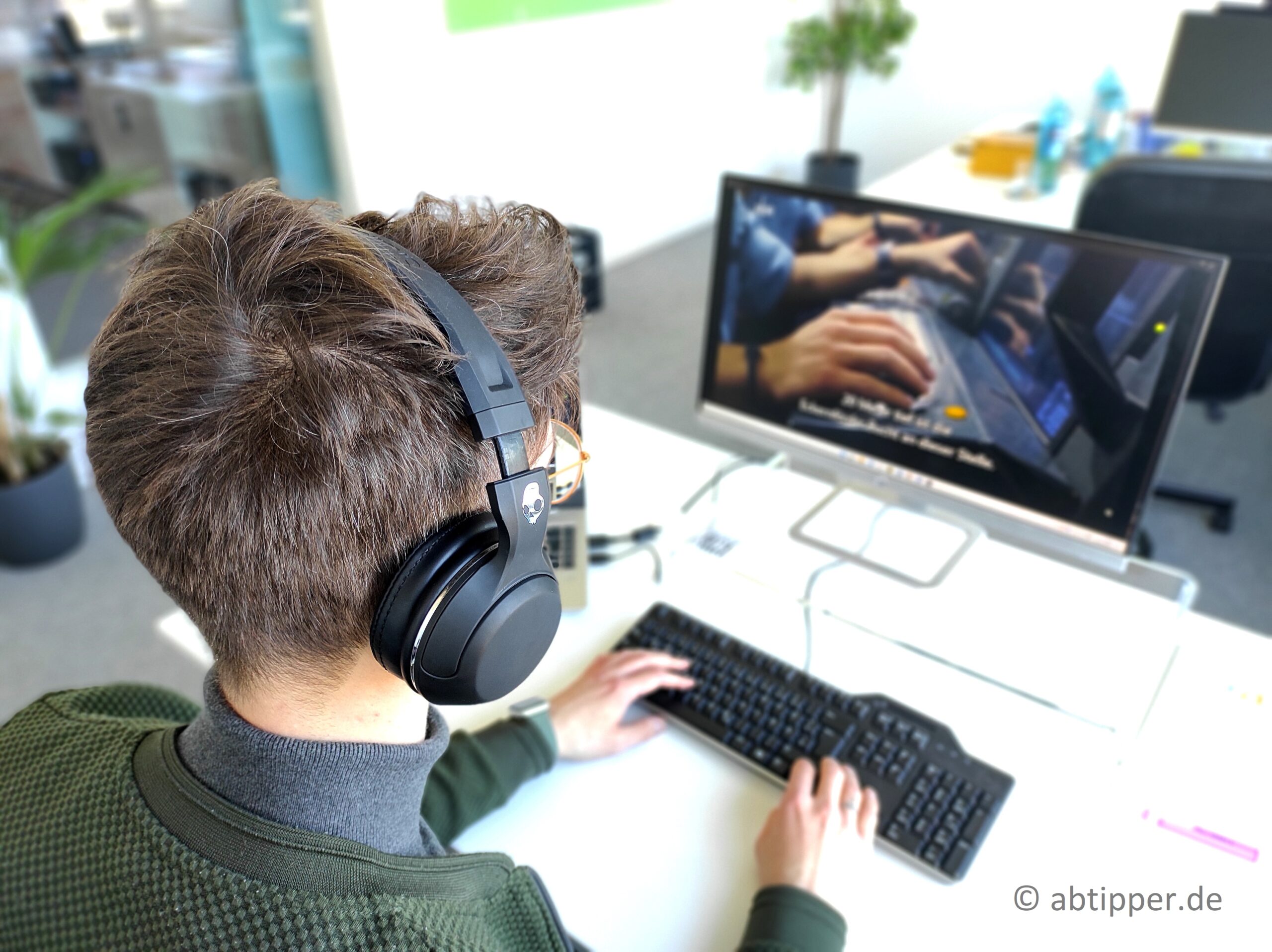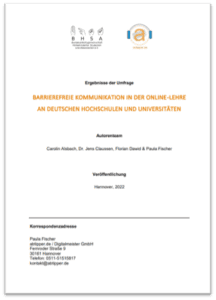Alle Maßnahmen der barrierefreien Kommunikation aus einer Hand

abtipper.de ist Ihr Partner für die barrierefreie Kommunikation. Wir erstellen für Sie ein kostenloses Konzept und unterstützen Sie gerne auch bei der Umsetzung.
Vereinbaren Sie jetzt Ihren unverbindlichen Beratungstermin!
abtipper.de is the largest German provider for the transcription of audio and video recordings. Our references:

[formidable id=“32″]
Barrierefreie Kommunikation, das ist Barrieren abbauen, gesetzliche Vorgaben einhalten, Commitment zeigen.
Weitere Informationen zur barrierefreien Kommunikation
- Studie zur barrierefreien Online-Lehre an deutschen Hochschulen
- Wichtige Begriffe zum Thema barrierefreie Kommunikation
Studie zu barrierefreie Online-Lehre an deutschen Hochschulen

Barrier-free communication
 In Deutschland leben über 80.000 gehörlose Personen, die einen Anspruch auf gesellschaftliche Teilhabe haben.
In Deutschland leben über 80.000 gehörlose Personen, die einen Anspruch auf gesellschaftliche Teilhabe haben.
Um für dieses wichtige Thema Barrierefreie Kommunikation eine größere Aufmerksamkeit zu erzeugen, haben wir gemeinsam mit der Bundesarbeitsgemeinschaft Hörbehinderter Studenten und Absolventen e.V. (BHSA) eine Umfrage zur barrierefreien Online-Lehre an deutschen Hochschulen durchgeführt.
Es zeigt sich, dass schon einiges erreicht wurde, bisher in Deutschland aber nur 28% der Online-Lehre barrierefrei sind. Es besteht also Handlungsbedarf!
Die Ergebnisse der Umfrage können Sie unter folgendem Link kostenlos herunterladen:
Behinderte Menschen haben ein Recht auf Bildung. Dazu zählt auch der barrierefreie Zugang zu einer allgemeinen Hochschulbildung. Durch die anhaltende Corona-Pandemie findet an den deutschen Hochschulen seit einigen Semestern primär Online-Lehre statt. PDFs, Videos und Podcasts kommen zum Einsatz. Wie zugänglich ist das Studium für behinderte Menschen derzeit?
Die Beantwortungen der Fragen zeigt auf, dass an den teilnehmenden Hochschulen und Universitäten das Thema digitale Barrierefreiheit nur eingeschränkt behandelt wird. Die teilnehmenden Hochschulen geben durchschnittlich an, dass nur 28 Prozent der Online-Lehre bereits barrierefrei sind. An keiner der teilnehmenden Hochschulen ist die gesamte Online-Lehre barrierefrei.
Die Ergebnisse der Umfrage zeigen, dass dringender Handlungsbedarf im Bereich barrierefreier Kommunikation in der Online-Lehre besteht. Auch im Hinblick auf die sich stetig verändernde rechtliche Lage ist es für Hochschulen und Universitäten durchaus sinnvoll, im Bereich der barrierefreien Kommunikation nachzurüsten.
Die Studie zur barrierefreien Kommunikation in der Online-Lehre an deutschen Hochschulen wurde von abtipper.de in Kooperation mit der Bundesarbeitsgemeinschaft Hörbehinderter Studenten und Absolventen e.V., kurz BHSA, durchgeführt.
Die BHSA ist eine Anlaufstelle für Fragen und Probleme im Alltag hörbehinderter Studierender. Sie versteht sich als Selbsthilfegruppe hörbehinderter Menschen im Studium sowie beim Berufseinstieg. Zu ihren Aktivitäten gehören unter anderem Kommunikationstrainings und Einführungsseminare. Die BHSA wurde 1986 gegründet und zählt ca. 300 Mitglieder.
Die Ergebnisse im Detail – Zusammenfassung
Die Studie zielt auf die Barrierefreiheit in der Online-Lehre an deutschen Hochschulen ab. Es handelt sich um digitale barrierefreie Kommunikation, also barrierefreies Internet. Unter barrierefreier Kommunikation werden verschiedene Maßnahmen der Barrierefreiheit zusammengefasst, unter anderem der Einsatz von Leichter Sprache, Gebärdensprache, Schriftdolmetschen, unterstützter Kommunikation und assistiven Technologien, Audiodeskription und Untertitelung für Menschen mit Hörbehinderung. Durch den Einsatz dieser Maßnahmen in der digitalen Online-Lehre sollen Kommunikationsbarrieren eingedämmt oder vollständig abgebaut werden.
Die Umfrage soll aufzeigen, inwiefern digitale Barrierefreiheit in der Online-Lehre umgesetzt und angestrebt wird. Dazu wurde eine Umfrage mit dem Titel „Barrierefreie Kommunikation in der Online-Lehre an Hochschulen und Universitäten“ durchgeführt. An der Umfrage haben 28 Vertreter und Vertreterinnen verschiedener deutscher Hochschulen und Universitäten teilgenommen.
Die Beantwortungen der Fragen zeigt auf, dass an den teilnehmenden Hochschulen und Universitäten das Thema digitale Barrierefreiheit zunehmend eine wichtige Rolle spielt.
Die teilnehmenden Hochschulen geben durchschnittlich an, dass 28 Prozent der Online-Lehre bereits barrierefrei sind.
An keiner der teilnehmenden Hochschulen ist die gesamte Online-Lehre barrierefrei. Die Ergebnisse der Umfrage zeigen, dass dringender Handlungsbedarf im Bereich barrierefreier Kommunikation in der Online-Lehre besteht. Auch im Hinblick auf die sich stetig verändernde rechtliche Lage ist es für Hochschulen und Universitäten durchaus sinnvoll, im Bereich der barrierefreien Kommunikation nachzurüsten.
Hintergrund der Studie zu barrierefreier Kommunikation
 Es wird davon ausgegangen, dass Kommunikationsbarrieren durch mündliche oder schriftliche Texte und dem Einsatz bestimmter Medien entstehen, die nicht an die intendierte Rezipient*innenschaft, hier die Studierenden, angepasst sind. Die Zielgruppe „Studierende“ ist dabei sehr heterogen und setzt sich aus Menschen mit und ohne Behinderung, Menschen mit divergierenden Lebenssituationen und/oder Menschen mit Deutsch als Mutter- oder Fremdsprache zusammen.
Es wird davon ausgegangen, dass Kommunikationsbarrieren durch mündliche oder schriftliche Texte und dem Einsatz bestimmter Medien entstehen, die nicht an die intendierte Rezipient*innenschaft, hier die Studierenden, angepasst sind. Die Zielgruppe „Studierende“ ist dabei sehr heterogen und setzt sich aus Menschen mit und ohne Behinderung, Menschen mit divergierenden Lebenssituationen und/oder Menschen mit Deutsch als Mutter- oder Fremdsprache zusammen.
Unter Online-Lehre wird im Zuge dieser Umfrage die digitale Lehre mithilfe des Internets verstanden. Dabei wird auf Systeme und Softwares wie beispielsweise Moodle, Zoom, BigBlueButton oder Dropbox zurückgegriffen. Ein Teil der Lehre wird durch das Hochladen von Audio- und/oder Videodateien unterstützt.
Dabei soll die externe und interne Internetpräsentation von Hochschulen und Universitäten im Einklang mit dem Behindertengleichstellungsgesetz (BGG) zur Umsetzung der Richtlinie (EU) 2016/21022 des Europäischen Parlaments und des Rates über den barrierefreien Zugang zu den Websites und mobilen Anwendungen öffentlicher Stellen gestaltet sein, um Inhalte nach Möglichkeit barrierefrei zugänglich zu gestalten. Zu beachten ist auch, dass basierend auf dem Behindertengleichstellungsgesetz (BGG) bundeslandeigene Gesetze wie das Sächsische Inklusionsgesetz (SächsInklusG) oder das Niedersächsische Behindertengleichstellungsgesetz (NBGG) existieren.
Ansatz der Studie zu barrierefreier Kommunikation
Die Umfrage soll aufzeigen, inwiefern digitale Barrierefreiheit in der Online-Lehre umgesetzt und angestrebt wird. Dazu wurde eine Umfrage mit dem Titel „Barrierefreie Kommunikation in der Online-Lehre an Hochschulen und Universitäten“ durchgeführt. Die Umfrage wurde an ca. 430 Pressestellen deutscher Hochschulen und Universitäten gerichtet.
Die Fragen bewegen sich dabei in folgenden Themenfeldern:
- Inwieweit beachten die Hochschulen und Universitäten die Vorgaben zur barrierefreien Kommunikation in der Online-Lehre?
- Falls dies noch nicht oder nur teilweise geschieht: Warum werden die Vorgaben noch nicht beachtet?
- Was muss geschehen, damit die Online-Lehre kurzfristig auch barrierefrei möglich ist?
Anhand der eingegangenen Beantwortungen lässt sich die Gewichtung von digitaler Barrierefreiheit in der Online-Lehre im Hochschulbereich ableiten. Zudem können anhand der Ergebnisse explizite Verbesserungsvorschläge für den Umgang mit dem Thema digitale Barrierefreiheit gemacht werden.
Auswertung der Ergebnisse der Studie zu barrierefreier Kommunikation
Die detaillierten Ergebnisse und die Antworten auf jede Einzelfrage finden Sie in der ausführlichen Version der Studie.

Anhand der eingegangenen Beantwortungen lässt sich die Gewichtung von digitaler Barrierefreiheit in der Online-Lehre im Hochschulbereich ableiten. Die Beantwortungen der Fragen zeigt auf, dass an den teilnehmenden Hochschulen und Universitäten das Thema digitale Barrierefreiheit zunehmend eine wichtige Rolle spielt. Die Umsetzung von Maßnahmen barrierefreier Kommunikation ist aber nicht immer vollständig.
Es gibt an rund 75% der Hochschulen und Universitäten eine(n) Beauftragte(n) für Barrierefreiheit oder eine ähnlich beauftragte Person, dennoch fehlen diesen Personen das Wissen, die Ressourcen und die (personelle) Unterstützung um digitale Barrierefreiheit umsetzen und durchsetzen zu können. Dies liegt unter anderem daran, dass die gesetzlichen Vorgaben zur Barrierefreiheit nicht oder nur teilweise bekannt sind. In dem Wintersemester 2021/22 variiert der Anteil von Online-Lehre stark, durchschnittlich die Hälfte der Lehre war digital, die andere Hälfte fand in Präsenzlehre statt. Einige Hochschulen boten nur Präsenzlehre an, wohingegen einige Hochschulen nur Online-Lehre angeboten haben.
Die teilnehmenden Hochschulen und Universitäten zeigten offen, dass der Anteil an angewandten Maßnahmen für barrierefreie Kommunikation sehr gering ausfällt. Nur 15 Prozent bieten immer „Barrierefreie Dokumente zum Download/per E-Mail“ an, 8 Prozent bieten immer „Untertitel bei Videoaufnahmen“ und lediglich 4 Prozent bieten immer „Transkriptionen von Ton- und Videoaufnahmen“ an. Viele Maßnahmen, wie „Audiodeskription bei Videoaufnahmen“ oder das Bereitstellen von Gebärdensprachdolmetscher*innen bei Video- oder Telefonkonferenzen“ werden nur teilweise oder auf Nachfrage angeboten. Maßnahmen wie das Bereitstellen von „Schriftdolmetscher*innen bei Video- oder Telefonkonferenzen“ werden bei 75 Prozent nie bereitgestellt.
Dementsprechend geben die teilnehmenden Hochschulen durchschnittlich an, dass 28 Prozent der Online-Lehre bereits barrierefrei sind. An keiner der teilnehmenden Hochschulen ist die gesamte Online-Lehre barrierefrei, der höchstgeschätzte Wert lag bei 80 Prozent.
Durch die Umfrage an deutschen Hochschulen zu dem Thema „Barrierefreie Online-Lehre“ ist verdeutlicht worden, dass Barrierefreiheit im digitalen studentischen Alltag noch wenig präsent ist.
Vor allem Kommunikationsbarrieren, welche durch die Sinnesorgane oder die kognitiven Voraussetzungen der Kommunikationsteilnehmer*innen und eine nicht barrierefreie Umgebung hervorgerufen werden, werden kaum bearbeitet. Dazu zählen Hör- oder Sehbeeinträchtigungen.
Kommunikationsbarrieren welche durch den Einsatz bestimmter Medien, wie Textdokumenten, Audio- oder Videodateien entstehen, die nicht an die intendierte Rezipient*innenschaft, hier die Studierenden, angepasst sind, könnten durch den Einsatz von Maßnahmen von barrierefreier Kommunikation abgebaut werden. Dazu zählen der Einsatz von Gebärdensprachdolmetscher*innen, Untertitelung und das Bereitstellen barrierefreier, also von einem Screenreader lesbaren, Textdokumente.
Die Ergebnisse der Umfrage zeigen, dass dringender Handlungsbedarf im Bereich barrierefreier Kommunikation in der Online-Lehre besteht. Auch im Hinblick auf die sich stetig verändernde rechtliche Lage ist es für Hochschulen und Universitäten durchaus sinnvoll, im Bereich der barrierefreien Kommunikation nachzurüsten.
Wichtige Begriffe zum Thema barrierefreie Kommunikation
Gebärdensprachdolmetscher*innen übersetzen die deutsche Lautsprache in die Gebärdensprache und andersherum. Sie erleichtern die Kommunikation zwischen gehörgeschädigten und hörenden Menschen. In Deutschland werden vorläufig die Deutsche Gebärdensprache (DGS) oder die Lautsprachbegleitenden Gebärden (LBG) genutzt.
Schriftdolmetscher*innen geben Reden, Vorträge oder weitere Wortbeiträge schriftlich wieder. Der Text ist beispielsweise auf einem Tablet oder auf einer Leinwand zu sehen. Durch zeitnahes Schriftdolmetschen wird die Teilhabe von hörgeschädigten Personen ermöglicht.
Ein Transkript ist eine Verschriftlichung von Audio- und Videoaufnahmen. Im Gegensatz zum Schriftdolmetschen wird der Text nicht zeitgleich mit dem mündlichen Text wiedergegeben. Das Transkript wird im Nachhinein erstellt.
Als Audiodeskription werden in Dialogpausen eingesprochene Bild- und Situationsbeschreibungen bezeichnet. Handlungen, Personen oder Schauplätze werden beschrieben. Zusammen mit der originalen Tonspur ermöglicht die Audiodeskription blinden und seheingeschränkten Menschen das Verstehen von Videos und Filmen.
Barrierefreie Dokumente können beispielsweise von Screenreadern problemlos gelesen werden und werden dadurch für blinde und seheingeschränkte Menschen zugänglich. Dafür gibt es diverse, gesetzlich geregelte Vorgaben. Vor allem die richtige Formatierung ist dafür wichtig, aber auch eine sinnvolle inhaltliche Strukturierung erhöht die Rezipierbarkeit von Textdokumenten.
Was sind barrierefreie Untertitel?
Barrierefreie Untertitel enthalten im Gegensatz zu einfachen Untertiteln akustische Informationen wie Musik, Geräusche oder Off-Stimmen sowie paralinguistische Elemente wie Lautstärke, Tonhöhe oder Stimmmodifikationen wie Lachen oder Weinen.
Diese Elemente sind handlungstragend und ermöglichen Menschen mit Hörschädigung den vollständigen Zugang zu einer Videodatei. Sie vermitteln somit denselben Kenntnisstand, den auch Hörende durch die Audio erhalten.